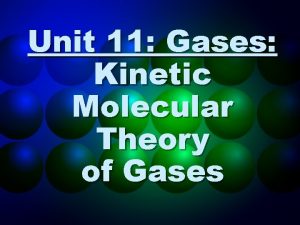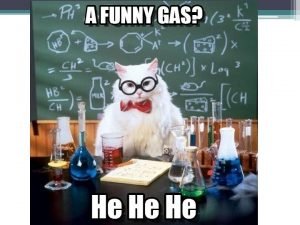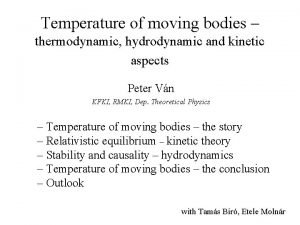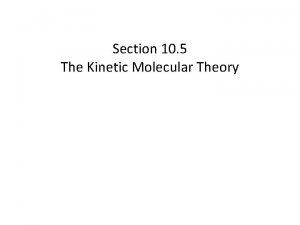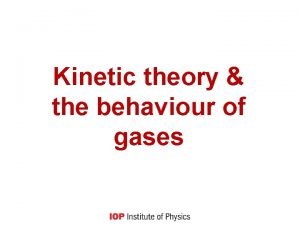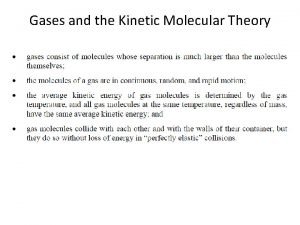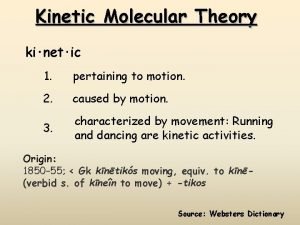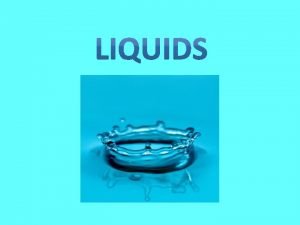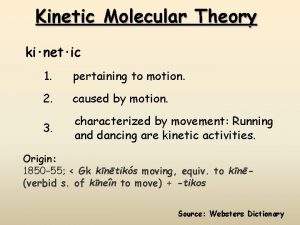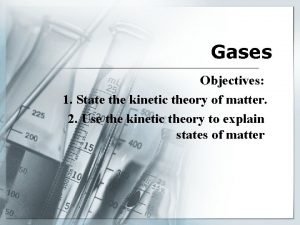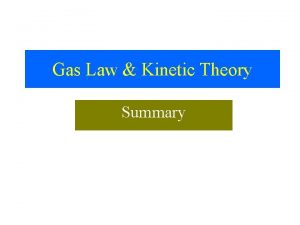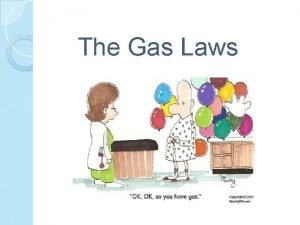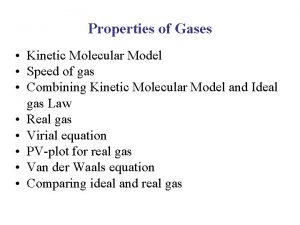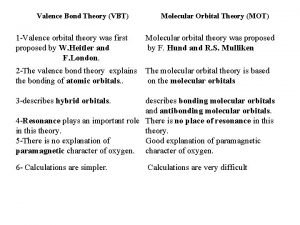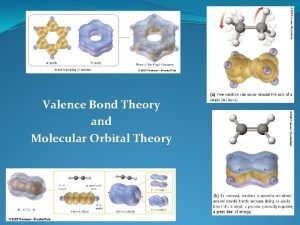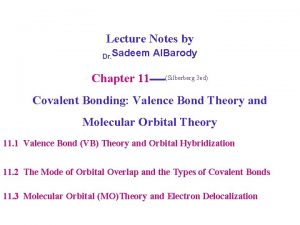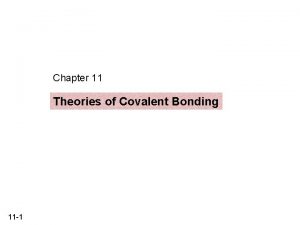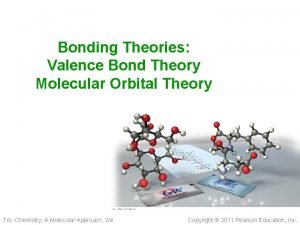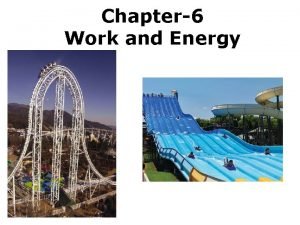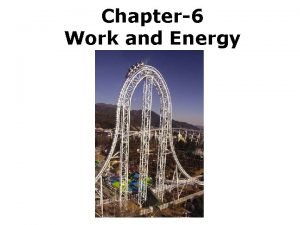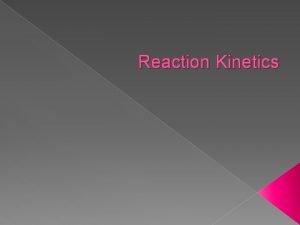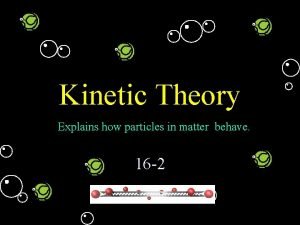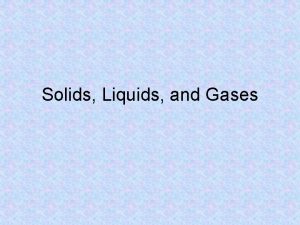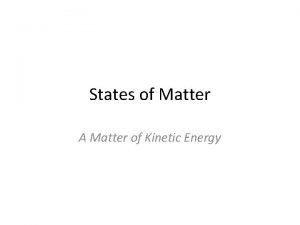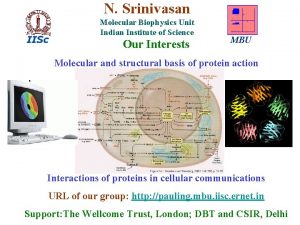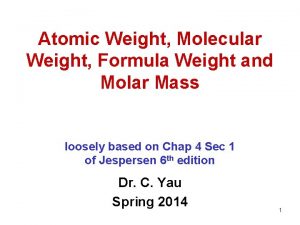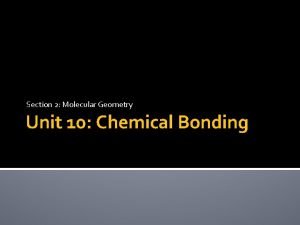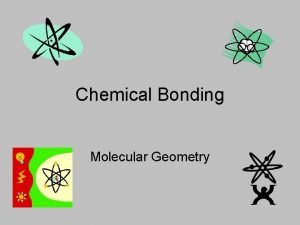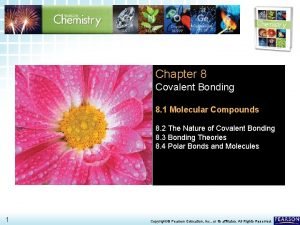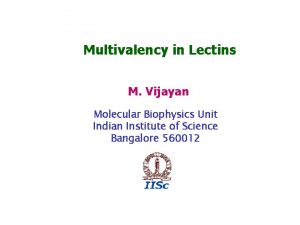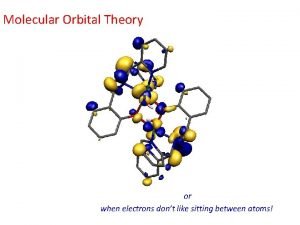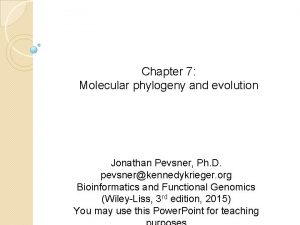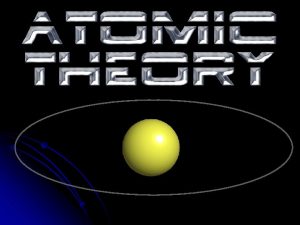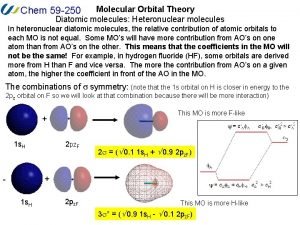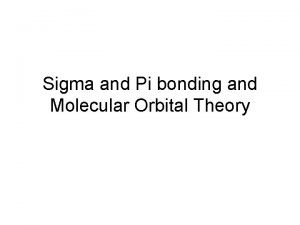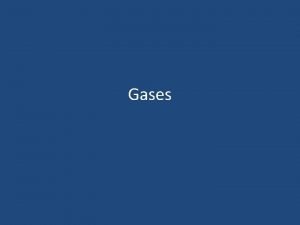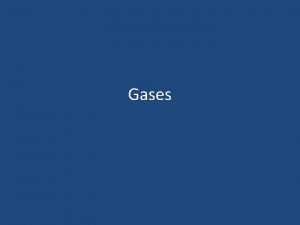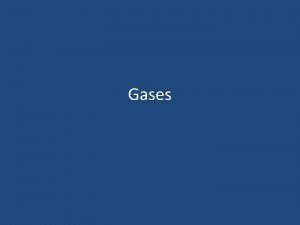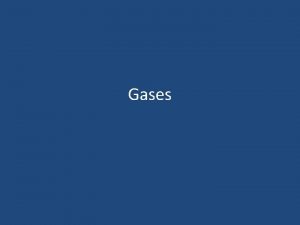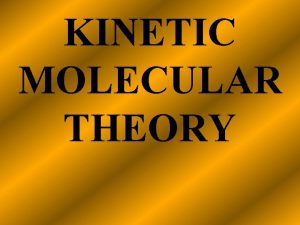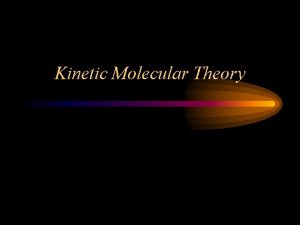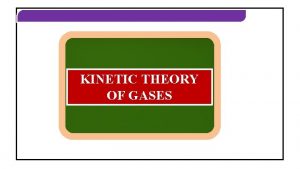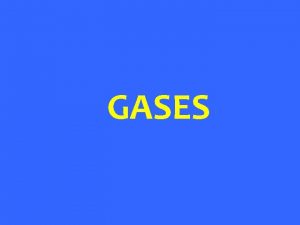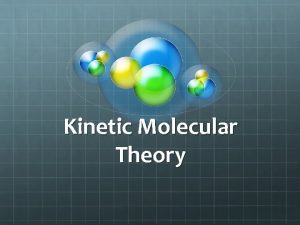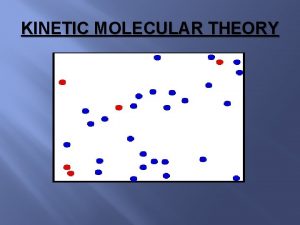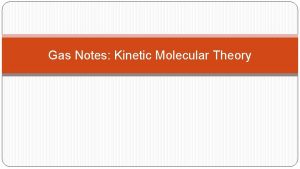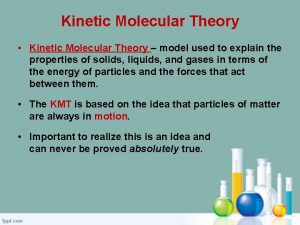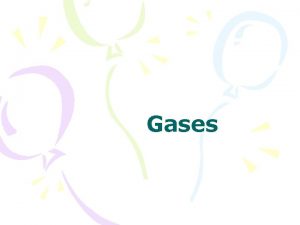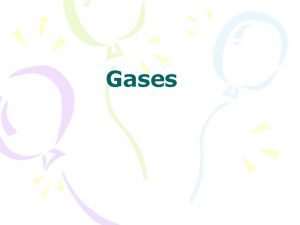Unit 6 Gases and the Kinetic Molecular Theory































































































- Slides: 95

Unit 6: Gases and the Kinetic Molecular Theory Pre-AP Chemistry 1

Characteristics of Gases • Gases expand to fill any container. • Random motion, no attraction • Gases are fluids (like liquids). • No attraction • Gases have very low densities. • No volume = lots of empty space 2

Characteristics of Gases • Gases can be compressed. • Small molecular volume = lots of empty space • Gases undergo diffusion & effusion. • Random motion 3

Gas Pressure • Pressure (P) is defined as the force exerted per unit of surface area: • Pressure = force / area • The earth’s gravitational attraction pulls the atmospheric gases toward its surface where they exert a force on all objects. The force of these gases creates a pressure of about 14. 7 pounds per square inch (lb/in 2; psi) of surface. • In a container, pressure is caused by the collisions of molecules with the container walls. 4

Pressure Which shoes create the most pressure? 5

Pressure occurs when a force is dispersed over a given surface area. F P= A Mass: 2000 kg Foot area: 5000 cm 2 If F acts over a large area… But if F acts over a small area… F = A 55 kg 60 cm 2 P P 6

Units of Pressure • SI unit of force is the newton (N) • • SI unit of pressure is the pascal (Pa) • • Other common units of pressure include: • Standard atmosphere (atm) the average atmospheric pressure measured at sea level and 0°C. • Millimeter of mercury (mm. Hg) based on measurement with a barometer or manometer • Also called the torr 7

Units of Pressure Unit Atmospheric Pressure Pascal (Pa); kilopascal (k. Pa) 1. 01325 x 105 Pa; 101. 325 k. Pa Atmosphere (atm) 1 atm Millimeters of mercury (mm. Hg) 760 mm. Hg Torr 760 torr Pounds per square inch (psi or lb/in 2) 14. 7 lb/in 2 Bar 1. 01325 bar ** These are all equivalent values. e. g. 1 atm = 760 torr 8

Converting Units of Pressure 1. The pressure of a sample of CO 2 is 291. 4 mm. Hg. Calculate the CO 2 pressure in torrs, atmospheres, and kilopascals. 2. If the pressure of a sample of O 2 is 642. 3 mm. Hg, calculate PO 2 in torrs, pascals, and lb/in 2. 9

The Barometer • • Barometer – a device used to measure atmospheric pressure Gases in the atmosphere exert a force down on the pool of mercury. The pressure is measured when equilibrium between the forces of atmospheric gases and the force of the mercury in the tube is reached. Common unit of pressure is height of mercury column in millimeters (mm. Hg) 10

Why Mercury? • Water column (34. 0 ft. high or 10. 4 m) Mercury filled 760 mm = 1 atm • Water filled 10400 mm = 1 atm Atmospheric pressure Mercury column (30. 0 in. high or 76 cm) The barometer measures air pressure 11

Barometric Pressure fraction of 1 atm 1 Sea level average altitude (m) (ft) 0 0 1/2 5, 486 18, 000 1/3 8, 376 27, 480 1/10 16, 132 52, 926 1/100 30, 901 101, 381 1/1000 48, 467 159, 013 1/10000 69, 464 227, 899 1/100000 96, 282 283, 076 On top of Mount Everest 12

The Manometer • Manometer – a device used to measure the pressure of a gas in an experiment 13

U-Tube Manometer U-tube Manometer 14

Manometer A ? 15

Manometer B ? 16

Solving Manometer Problems BIG = small + height = BIG - small BIG 112. 8 k. Pa 760 mm Hg = 846. 1 mm Hg 101. 3 k. Pa X mm Hg = 846. 1 mm Hg - 593 mm Hg X mm Hg = 253 mm Hg STEP 1) Decide which pressure is BIGGER STEP 2) Convert ALL numbers to the unit of unknown small STEP 3) Use formula Big = small + height 0. 780 atm height X mm Hg 0. 780 atm 760 mm Hg = 593 mm Hg 1 atm 17

Manometers Example 1 1. 0. 58 atm 98. 4 k. Pa X mm Hg 18

Manometers Example 2 2. X atm 125. 6 k. Pa 0 mm Hg Because no difference in height is shown in barometer, you only need to convert “k. Pa” into “atm”. 19

Manometers Example 3 3. X atm 135. 5 k. Pa 208 mm Hg 20

Gas Laws • Physical behavior of a gas can be described by four variables: • • Pressure (P) Volume (V) Temperature (T) Amount (number of moles n) • Variables are interdependent; that is any one of them can be determined by measuring the other three. • Three key relationships between these four variables: • Boyle’s Law • Charles’s Law • Avogadro’s Law • Laws are special cases of the ideal gas law. 21

Temperature Always use absolute temperature (Kelvin) when working with gases. ºF -459 ºC -273 K 0 32 212 0 100 273 373 K = ºC + 273 22

Pressure and Volume Experiment 1 Pressure (atm) 8. 0 Volume (L) 2. 0 Px. V (atm x L) 16 2 4. 0 _____ 3 2. 0 8. 0 _____ 4 1. 0 16 _____ Boyle's Law P x V = k (constant) when T remains constant P 1 V 1= 8. 0 atm x 2. 0 L = 16 atm L P 2 V 2= 4. 0 atm x 4. 0 L = 16 atm L P 1 V 1 = P 2 V 2 = k 23

Boyle’s Law • • Describes the relationship between volume and pressure. Law states: • At constant temperature, the volume occupied by a fixed amount of gas is inversely proportional to the applied (external) pressure [ T and n fixed] • PV=constant • V = constant / P • In general, if volume of the gas increases, the pressure of the gas decreases, and vice versa. 24

Boyle’s Law Examples 1. A sample of nitrogen gas is 6. 4 L at a pressure of 0. 70 atm. What will the new volume be if the pressure is changed to 1. 40 atm? (T constant) 2. A sample of helium gas has a volume of 12. 0 L at 600. mm Hg. What new pressure is needed to change the volume to 36. 0 L? (T constant) 25

Boyle’s Law Examples 3. A sample of oxygen gas is 3. 3 L at a pressure of 48. 6 k. Pa. What will the new pressure be if the volume is changed to 1. 1 L? (T constant) 4. Freon-12, CCl 2 F 2, is used in refrigeration systems. What is the new volume (L) of a 1. 6 L sample of Freon gas initially at 50 mm Hg after its pressure is changed to 200 mm Hg at constant T? 26

Charles’ Law V = 125 m. L T = 273 K V T = 250 m. L = 546 K Observe the V and T of the balloons. How does volume change with temperature? 27

Charles’s Law • • Describes the relationship between volume and temperature. Law states: • At constant pressure, the volume occupied by a fixed amount of gas is directly proportional to its absolute temperature [P and n fixed] • • V/T = constant • V = constant * T As temperature increases, volume increases, and vice versa. 28

Charles’ Law Examples Use Charles’ Law to complete the statements below: 1. If final T is higher than initial T, final V is (greater, or less) than the initial V. 2. If final V is less than initial V, final T is (higher, or lower) than the initial T. 29

Charles’ Law Examples 1. A balloon has a volume of 785 m. L on a fall day when the temperature is 21°C. In the winter, the gas cools to 0°C. What is the new volume of the balloon? 2. A sample of oxygen gas has a volume of 420 m. L at a temperature of 18°C. What temperature (in °C) is needed to change the volume to 640 m. L? 30

Gay-Lussac’s Law • At constant volume, the pressure exerted by a fixed amount of gas is directly proportional to the absolute temperature [V and n fixed] • As temperature increases, pressure increases, and vice versa. 31

Gay-Lussac’s Law Examples Use Gay-Lussac’s law to complete the statements below: 1. When temperature decreases, the pressure of a gas (decreases or increases). 2. When temperature increases, the pressure of a gas (decreases or increases). 32

Gay-Lussac’s Law Examples 1. A gas has a pressure at 2. 0 atm at 18°C. What will be the new pressure if the temperature rises to 62°C? (V constant) 2. A gas has a pressure of 3. 8 atm at 27°C. What will the temperature be if the pressure decreases to 1. 9 atm? (V constant) 33

Understanding Gas Laws Complete with 1) Increases 2) Decreases 3) Does not change A. Pressure _____, when V decreases B. When T decreases, V _____. C. Pressure _____ when V changes from 12. 0 L to 24. 0 L (constant n and T) D. Volume _____when T changes from 15. 0 °C to 45. 0°C (constant P and n) 34

Combined Gas Law • Combining Boyle’s and Charles’ laws gives the Combined Gas Law 35

Combined Gas Law Problems 1. If a 2. 0 L sample of gas at 3. 0 atm and 52°C is compressed to 1. 0 L at 25°C, find the pressure of the gas. 2. If nitrogen gas at 23°C and 746 mm. Hg occupies 10. 1 cm 3, what volume would the gas occupy at 0°C and 760 mm. Hg? 36

Avogadro’s Law • • Describes the relationship between volume and amount. Law states: • At constant temperature and pressure, equal volumes of any ideal gas contain equal numbers of particles (or moles). [P and T fixed] • V / n = constant • V = constant * n • As number of moles increases, volume increases, and vice versa. 37

Avogadro’s Law Problems Assume P and T are fixed. 1. If 1. 5 mol of O 2 occupies 3. 2 cm 3, how many moles of O 2 would occupy 6. 4 cm 3? 2. If a 56 g sample of N 2 occupies 4. 6 L, what volume will 168 g of N 2 occupy? 38

Avogadro’s Law Problems Assume P and T are fixed. 3. If 2. 6 mol of F 2 occupies 6. 1 dm 3, what volume will 2. 6 mol of Cl 2 occupy? 39

Standard Conditions • Chemists use a set of standard conditions called standard temperature and pressure (STP): • STP: 0 °C (273. 15 K) and 1 atm (760 torr) • Standard molar volume = 22. 4 L • The volume of 1 mol of an ideal gas 40

Molar Volume 1 mol of a gas @ STP has a volume of 22. 4 L 41

Ideal Gas Law • Each of the gas laws focuses on the effect of changes in one variable on gas volume. • Can combine these individual effects into one relationship • R is a proportionality constant known as the universal gas constant 42

Universal Gas Constant Values of R 43

Ideal Gas Law Examples 1. Given the following sets of values, calculate the unknown quantity. a) P = 1. 01 atm V = ? n = 0. 00831 mol T = 25°C b) P = ? V= 0. 602 L n = 0. 00801 mol T = 311 K 44

Ideal Gas Law Problems 2. At what temperature would 2. 10 moles of N 2 gas have a pressure of 1. 25 atm and in a 25. 0 L tank? 45

Ideal Gas Law Problems 3. When filling a weather balloon with gas you have to consider that the gas will expand greatly as it rises and the pressure decreases. Let’s say you put about 10. 0 moles of He gas into a balloon that can inflate to hold 5000. 0 L. Currently, the balloon is not full because of the high pressure on the ground. What is the pressure when the balloon rises to a point where the temperature is -10. 0°C and the balloon has completely filled with the gas. 46

Ideal Gas Law Problems 4. What volume is occupied by 5. 03 g of O 2 at 28°C and a pressure of 0. 998 atm? 5. Calculate the pressure in a 212 liter tank containing 23. 3 kg of argon gas at 25°C? 47

Ideal Gas Law PV = n. RT Fixed n and T Boyle’s Law V = constant / P or V = n. RT / P Fixed P and T Fixed n and P Charles’s Law V = constant * T Avogadro’s Law V = constant * n 48

Solving Gas Law Problems 1. A sample of air occupies 24. 8 cm 3 at 1. 12 atm. The pressure of the air is increased to 2. 64 atm. Assuming constant temperature, what is the new volume of the air (in L)? 2. A sample of argon gas occupies 105 m. L at 0. 871 atm. If the temperature remains constant, what is the volume (in L) at 26. 3 k. Pa? 49

Solving Gas Law Problems 3. A 1. 0 L steel tank is fitted with a safety valve that opens if the internal pressure exceeds 1. 00 x 103 torr. It is filled with helium at 23 °C and 0. 991 atm and placed in boiling water at exactly 100 °C. Will the safety valve open? 4. An engineer pumps air at 0 °C into a newly designed piston cylinder assembly. The volume measures 6. 83 cm 3. At what temperature (in K) would the volume be 9. 75 cm 3? 50

Solving Gas Law Problems 5. A scale model of a blimp rises when it is filled with helium to a volume of 55. 0 dm 3. When 1. 10 mol of He is added to the blimp, the volume is 26. 2 dm 3. How many more grams of He must be added to make it rise? Assume constant T and P. 6. A rigid plastic container holds 35. 0 g of ethylene gas (C 2 H 4) at a pressure of 793 torr. What is the pressure if 5. 0 g of ethylene is removed at constant temperature? 51

Solving Gas Law Problems 7. A steel tank has a volume of 438 L and is filled with 0. 885 kg of O 2. Calculate the pressure of O 2 at 21 °C. 8. The tank in problem 7 develops a slow leak that is discovered and sealed. The new measured pressure is 1. 37 atm. How many grams of O 2 remain? 52

Density of a Gas • • One mole of any gas occupies nearly the same volume at a given temperature and pressure. The density (d = m/V) depends on differences in molar mass. • e. g. at STP, 1 mol O 2 occupies the same volume as 1 mol N 2, but since each O 2 molecule has a greater mass than each N 2 molecule, O 2 is denser. • All gases are miscible when thoroughly mixed but in the absence of mixing, a less dense gas will lie above a more dense one. 53

Calculating Gas Density • Number of moles is mass divided by molar mass. • The density of a gas is directly proportional to its molar mass. • A given amount of a heavier gas occupies the same volume as that amount of a lighter gas (Avogadro’s law). • The density of a gas is inversely proportional to the temperature. • As the volume of a gas increases with temperature (Charles’s law, the same mass occupies more space; thus the density is lower. 54

Calculating Gas Density 1. Calculate the density (in g/L) of carbon dioxide a. At STP (0 °C and 1 atm) b. 2. At ordinary room conditions (20 °C and 1. 00 atm) Compare the density of SO 2 at 0 °C and 380 torr with its density at STP. 55

Molar Mass of a Gas • Rearrange the ideal gas law: 56

Finding the Molar Mass of a Gas 1. An organic chemist isolates from a petroleum sample a colorless liquid with the properties of cyclohexane (C 6 H 12). She obtains the following data to determine its molar mass: Ø Volume (V) of flask = 213 m. L Ø Mass of flask + gas = 78. 416 g Ø Mass of flask = 77. 834 g Ø T = 100. 0 °C Ø P = 754 torr 57

Finding the Molar Mass of a Gas 2. At 10. 0 °C and 102. 5 k. Pa, the density of dry air is 1. 26 g/L. What is the molar mass of dry air at these conditions? 58

Dalton’s Law of Partial Pressure • • Gases mix homogeneously (form a solution) in any proportions. Each gas in a mixture behaves as if it were the only gas present (assuming no chemical interactions). Each gas in a mixture exerts a partial pressure, a portion of the total pressure of the mixture, that is the same as the pressure it exerts by itself. Law states: • In a mixture of unreacting gases, the total pressure is the sum of the partial pressures of the individual gases. Ptotal = P 1 + P 2 + P 3 + …. 59

Gas Mixtures and Dalton’s Law 60

Partial Pressure • • Each gas in a mixture of gases behaves independently. Develop a relationship between partial pressure of a gas and the moles of the gas. • e. g. A mixture of hydrogen and nitrogen gases 61

Partial Pressure (2) • The fraction of the total number of moles in a mixture that each component in a mixture contributes is called the mole fraction (X) of that component. • Multiplying X by 100 gives mole percent • • • The sum of the mole fractions of all components in any mixture must be 1 (mole percent = 100) Mole Fraction: Since the total pressure is due to the total number of moles, the partial pressure of gas A is the total pressure multiplied by the mole fraction of A, XA. 62

Partial Pressure Examples 1. In a study of O 2 uptake by muscle at high altitude, a physiologist prepares an atmosphere consisting of 79 mole % N 2, 17 mole % O 2, and 4. 0 mole % CO 2. The pressure of the mixture is 0. 75 atm to simulate high altitude. Calculate the mole fraction and partial pressure of oxygen in the mixture. 63

Partial Pressure Examples 2. A mixture of noble gases consisting of 5. 50 g of He, 15. 0 g of Ne, and 35. 0 g of Kr is placed in a pistoncylinder assembly at STP. Calculate the partial pressure of each gas. 64

Vapor Pressure • • Vapor pressure is the partial pressure of a substance over its liquid/solid form. Varies with temperature and identity of the substance. 65

Vapor Pressure Curves 61. 3 o. C 101. 3 78. 4 o. C 100 o. C lor alc o of ho or 66. 6 l m 80. 0 53. 3 eth yl ch Pressure (KPa) 93. 3 40. 0 r w 26. 7 e at 13. 3 0 10 20 30 40 50 60 70 80 90 100 Temperature (o. C) 66

Vapor Pressure of Water at Various Temperature °C Pressure (mm. Hg) 0 4. 6 10 9. 2 15 12. 8 17 14. 5 19 16. 5 21 18. 7 23 21. 1 25 23. 8 27 26. 7 30 31. 8 40 55. 3 60 149. 4 80 355. 1 100 760. 0 67

Gas Collected Over Water 68

Collecting Gases Over Water • • Some chemical reactions produce gases which are collected over water. The total pressure is the sum of the water vapor pressure and the partial pressure of the collected gas. The partial pressure of the gas can be calculated by subtracting the vapor pressure of water from the total pressure. The amount of gas collected can be determined from the partial pressure of the gas and the ideal gas law. 69

Gas Collected Over Water Examples 1. If 156 m. L of hydrogen gas is collected at 19°C and 769 mm. Hg total pressure, a. Calculate the partial pressure of hydrogen gas. b. Calculate the mass of hydrogen collected. 70

Gas Collected Over Water Examples 2. If 254 m. L of oxygen gas is collected at 27°C and 655 mm. Hg total pressure, calculate the mass of oxygen gas collected. 71

Stoichiometry and the Ideal Gas Law 1. A laboratory-scale method for reducing a metal oxide is to heat it with H 2. The pure metal and H 2 O are products. What volume of H 2 at 765 torr and 225°C is needed to form 35. 5 g of Cu from copper (II) oxide? Cu. O(s) + H 2(g) Cu(s) + H 2 O (g) 72

Stoichiometry and the Ideal Gas Law 2. Sulfuric acid reacts with sodium chloride to form aqueous sodium sulfate and hydrogen chloride gas. How many milliliters of gas form at STP when 117 g of sodium chloride reacts with excess sulfuric acid? 73

Stoichiometry and the Ideal Gas Law 3. The alkali metals react with the halogens to form ionic metal halides. What mass of potassium chloride forms when 5. 25 L of chlorine gas at 0. 950 atm and 293 K reacts with 17. 0 g of potassium? 74

Stoichiometry and the Ideal Gas Law 4. Ammonia and hydrogen chloride gases react to form solid ammonium chloride. A 10. 0 L reaction flask contains ammonia at 0. 452 atm and 22°C, and 155 m. L of hydrogen chloride gas at 7. 50 atm and 271 K is introduced. After the reaction occurs, and the temperature returns to 22°C, what is the pressure inside the flask? 75

Kinetic Molecular Theory • • Developed most notably by James Maxwell and Ludwig Boltzmann Postulates: • Postulate 1: Gases are composed of molecules whose size is negligible compared with the average distance between them. • Postulate 2: Molecules move randomly in straight lines in all directions and at various speeds. • Postulate 3: The forces of attraction or repulsion between two molecules in a gas are very weak or negligible, except when they collide. • Postulate 4: When molecules collide with one another, the collisions are elastic. • Postulate 5: The average kinetic energy of a molecule is proportional to the absolute temperature. 76

Kinetic Molecular Theory Postulates Evidence 1. Gases are tiny molecules in mostly empty space. The compressibility of gases. 2. The molecules move in constant, rapid, random, straight-line motion. Gases mix rapidly. 3. There are no attractive forces between molecules. Gases do not clump. 4. The molecules collide elastically with container walls and one another. Gases exert pressure that does not diminish over time. 5. The average kinetic energy of the molecules is proportional to the Kelvin temperature of the sample. Charles’ Law 77

Average Kinetic Energy • Kinetic energy of an object is the energy associated with its motion. • Ek = ½ mass * speed 2 • If a heavy object and a light object have the same kinetic energy, the heavy object must be moving more slowly. • Average kinetic energy for a large population of molecules is molecular mass and is the average of the squares of the molecular speeds. 78

Root-Mean-Square Speed • The square root of is called the root mean square speed, or rms speed (urms). • A molecule moving at this speed has the average kinetic energy. • Root mean square speed is related to temperature and molar mass by • • R is the gas constant (8. 314 J/mol K) T is the absolute temperature M is the molar mass (kg/mol) Urms is in m/s 79

Root Mean Square Speed Examples 1. Calculate the root mean square speed of O 2 molecules in a tank at 21°C and 15. 7 atm. 2. Calculate the root mean square speed of N 2 molecules in a tank at 33°C and 4. 8 atm. 80

Root Mean Square Speed Examples 3. At what temperature does the root mean square speed of H 2 molecules in a tank equal 675 m/s? 81

Effusion • Effusion – the process by which a gas escapes from its container through a tiny hole into an evacuated space. • Thomas Graham concluded that effusion rate is inversely proportional to the square root of the gas density. • Effusion rate is the number of moles (or molecules) of gas effusing per unit time. • Graham’s law of effusion: • The rate of effusion of a gas is inversely proportional to the square root of its molar mass. 82

Applying Graham’s Law • • • Graham’s Law can be used to compare the rates of effusion of two gases. The ratio of rates of effusion is The gas with the lower molar mass effuses faster because the most probable speed of its molecules is higher; therefore, more molecules escape per unit time. 83

Graham’s Law Example Problems 1. Calculate the ratio of the effusion rates of helium and methane (CH 4) 2. Calculate the ratio of the effusion rates of hydrogen and carbon dioxide. 84

Graham’s Law Example Problems 3. If argon gas effuses twice as fast as an unknown gas, calculate the molar mass of the unknown gas. 4. If it takes 1. 25 min for 0. 010 mol of He to effuse, how long will it take for the same amount of ethane (C 2 H 6) to effuse? 85

Diffusion • • Gaseous Diffusion – the movement of one gas through another Closely related to effusion. Can also be described by Graham’s law. Diffusion of gases through liquids is much slower because the distances between molecules are much shorter in a liquid than in a gas so collisions are much more frequent. • Important biological process, e. g. oxygen moving from the lungs to the blood 86

Gas Law Calculations Boyle’s Law Avogadro’s Law P 1 V 1 = P 2 V 2 Add or remove gas Manometer Charles’ Law V 1 = V 2 T 1 = T 2 Gay-Lussac P 1 = P 2 T 1 = T 2 Combined P 1 V 1 = P 2 V 2 T 1 = T 2 Ideal Gas Law PV = n. RT Big = small + height Graham’s Law diffusion vs. effusion Dalton’s Law Partial Pressures PT = P A + P B 87

Real Gases – Deviations from Ideal • Real gases differ from the “ideal gas”: • Molecules have volume and are not simply points of mass. • Molecules contain attractive and repulsive forces. • At relatively high temperatures and low pressures, most simple gases exhibit nearly ideal behavior, but deviate slightly. • At low temperatures and very high pressures, gases can deviate significantly. 88

Deviations from Ideal Behavior • At moderately high pressure, values of PV/RT lower then ideal are due predominantly to intermolecular attractions. • At very high pressure, values of PV/RT greater than ideal are due predominantly to molecular volume. 89

Behavior of Real Gases ** For 1 mole of gas. 90

Deviations from Ideal Behavior • Intermolecular attractions • Attractive forces between molecules are much weaker than the covalent bonding forces that hold a molecule together. • At normal pressures, the spaces between gas molecules are so large that attractions are negligible, but as the pressure rises, the volume of the sample decreases and the average intermolecular distance becomes smaller. Therefore, the attractions have greater effect. • Molecular volume • At normal pressures, the space between molecules is enormous compared with the volume of the molecules themselves so the free volume is essentially equal to the container volume. • As pressure increases, the free volume decreases so the molecular volume makes up a greater proportion of the container volume. • At very high pressures, the free volume becomes significantly less than the container volume and the effect of the molecular volume becomes increasingly important. 91

van der Waals Equation • van der Waals equation is a redesign of the ideal gas law to account for the behavior of real gases. • Adjusts the measured pressure up by adding a factor that accounts for intermolecular attractions. • Adjusts the measured volume down by subtracting a factor from the entire container volume that accounts for the molecular volume. • a and b are van der Waals constants (experimentally determine positive numbers specific for a given gas) • a relates to the intermolecular attractions; b relates to the molecular volume • The constants a and b are zero for an ideal gas because the particles do not attract each other and have no volume. • At ordinary conditions, the van der Waals equation becomes the ideal gas equation. 92

Rearranging van der Waals • van der Waals can be rearranged to solve for pressure 93

Using van der Waals Equation 1. A 1. 98 L vessel contains 4. 89 mol of CO 2(g) at 299 K. Calculate the pressure in the vessel using: a. the ideal gas law b. van der Waals equation • a = 3. 59 atm*L 2/mol 2 • b = 0. 0427 L/mol 94

Using van der Waals Equation 2. A 3. 2 L vessel contains 42 g of ammonia (NH 3) at 338 K. Calculate the pressure in the vessel using: a. the ideal gas law b. van der Waals equation • a = 4. 17 atm*L 2/mol 2 • b = 0. 0371 L/mol 95
 Kinetic molecular theory of gases
Kinetic molecular theory of gases Molecular theory of gases and liquids
Molecular theory of gases and liquids Kinetic particle theory of matter
Kinetic particle theory of matter Kinetic theory of gases
Kinetic theory of gases Postulate of kinetic theory
Postulate of kinetic theory Kinetic theory
Kinetic theory Write the postulates of kinetic theory of gases
Write the postulates of kinetic theory of gases Write the postulates of kinetic theory of gases
Write the postulates of kinetic theory of gases Kinetic theory
Kinetic theory Kinetic molecular theory of liquids and solids
Kinetic molecular theory of liquids and solids Kinetic molecular theory of liquids and solids
Kinetic molecular theory of liquids and solids The kinetic molecular theory
The kinetic molecular theory Kinetic molecular theory of liquids
Kinetic molecular theory of liquids Kinetic energy molecular theory
Kinetic energy molecular theory Kinetic molecular theory def
Kinetic molecular theory def Theory vs hypothesis
Theory vs hypothesis Charles law in terms of kinetic molecular theory
Charles law in terms of kinetic molecular theory Ideal gas law examples
Ideal gas law examples Kinetic molecular theory formula
Kinetic molecular theory formula Kinetic molecular theory
Kinetic molecular theory Tenets of kinetic molecular theory
Tenets of kinetic molecular theory Molecular orbital diagram of f2
Molecular orbital diagram of f2 Basic principle of valence bond theory
Basic principle of valence bond theory Valence bond theory and molecular orbital theory
Valence bond theory and molecular orbital theory Theories of covalent bonding
Theories of covalent bonding Sof4 lewis structure
Sof4 lewis structure Qumica
Qumica Physical state of covalent compounds
Physical state of covalent compounds Giant molecular structure vs simple molecular structure
Giant molecular structure vs simple molecular structure Zinc oxide + nitric acid → zinc nitrate + water
Zinc oxide + nitric acid → zinc nitrate + water Unit 24 cutting with oxyfuels and other gases
Unit 24 cutting with oxyfuels and other gases Unit 10, unit 10 review tests, unit 10 general test
Unit 10, unit 10 review tests, unit 10 general test Si unit for kinetic energy
Si unit for kinetic energy Si unit for kinetic energy
Si unit for kinetic energy The kinetic theory of matter states that
The kinetic theory of matter states that Kinetic theory of matter definition
Kinetic theory of matter definition Define kinetic theory of matter
Define kinetic theory of matter Buoyancyability
Buoyancyability Kinetic theory of solids
Kinetic theory of solids What is a kinetic theory of matter
What is a kinetic theory of matter N srinivasan iisc passed away
N srinivasan iisc passed away Molecular weight unit
Molecular weight unit Unit chemical bonding molecular geometry
Unit chemical bonding molecular geometry Unit chemical bonding molecular geometry
Unit chemical bonding molecular geometry What is the representative unit in a molecular compound?
What is the representative unit in a molecular compound? Molecular biophysics unit
Molecular biophysics unit Molecular clock theory
Molecular clock theory Mot of co
Mot of co Neutral theory of molecular evolution notes
Neutral theory of molecular evolution notes Atomic molecular theory
Atomic molecular theory Heteronuclear diatomic molecules molecular orbital theory
Heteronuclear diatomic molecules molecular orbital theory How to memorize molecular geometry
How to memorize molecular geometry Sigma orbital and pi orbital
Sigma orbital and pi orbital Frontier molecular orbital theory
Frontier molecular orbital theory Hát kết hợp bộ gõ cơ thể
Hát kết hợp bộ gõ cơ thể Bổ thể
Bổ thể Tỉ lệ cơ thể trẻ em
Tỉ lệ cơ thể trẻ em Gấu đi như thế nào
Gấu đi như thế nào Tư thế worm breton
Tư thế worm breton Chúa yêu trần thế
Chúa yêu trần thế Môn thể thao bắt đầu bằng chữ f
Môn thể thao bắt đầu bằng chữ f Thế nào là hệ số cao nhất
Thế nào là hệ số cao nhất Các châu lục và đại dương trên thế giới
Các châu lục và đại dương trên thế giới Cong thức tính động năng
Cong thức tính động năng Trời xanh đây là của chúng ta thể thơ
Trời xanh đây là của chúng ta thể thơ Mật thư tọa độ 5x5
Mật thư tọa độ 5x5 Phép trừ bù
Phép trừ bù Phản ứng thế ankan
Phản ứng thế ankan Các châu lục và đại dương trên thế giới
Các châu lục và đại dương trên thế giới Thơ thất ngôn tứ tuyệt đường luật
Thơ thất ngôn tứ tuyệt đường luật Quá trình desamine hóa có thể tạo ra
Quá trình desamine hóa có thể tạo ra Một số thể thơ truyền thống
Một số thể thơ truyền thống Cái miệng bé xinh thế chỉ nói điều hay thôi
Cái miệng bé xinh thế chỉ nói điều hay thôi Vẽ hình chiếu vuông góc của vật thể sau
Vẽ hình chiếu vuông góc của vật thể sau Biện pháp chống mỏi cơ
Biện pháp chống mỏi cơ đặc điểm cơ thể của người tối cổ
đặc điểm cơ thể của người tối cổ Thế nào là giọng cùng tên
Thế nào là giọng cùng tên Vẽ hình chiếu đứng bằng cạnh của vật thể
Vẽ hình chiếu đứng bằng cạnh của vật thể Tia chieu sa te
Tia chieu sa te Thẻ vin
Thẻ vin đại từ thay thế
đại từ thay thế điện thế nghỉ
điện thế nghỉ Tư thế ngồi viết
Tư thế ngồi viết Diễn thế sinh thái là
Diễn thế sinh thái là Dạng đột biến một nhiễm là
Dạng đột biến một nhiễm là Số nguyên tố là
Số nguyên tố là Tư thế ngồi viết
Tư thế ngồi viết Lời thề hippocrates
Lời thề hippocrates Thiếu nhi thế giới liên hoan
Thiếu nhi thế giới liên hoan ưu thế lai là gì
ưu thế lai là gì Khi nào hổ mẹ dạy hổ con săn mồi
Khi nào hổ mẹ dạy hổ con săn mồi Khi nào hổ con có thể sống độc lập
Khi nào hổ con có thể sống độc lập Hệ hô hấp
Hệ hô hấp Từ ngữ thể hiện lòng nhân hậu
Từ ngữ thể hiện lòng nhân hậu Thế nào là mạng điện lắp đặt kiểu nổi
Thế nào là mạng điện lắp đặt kiểu nổi



